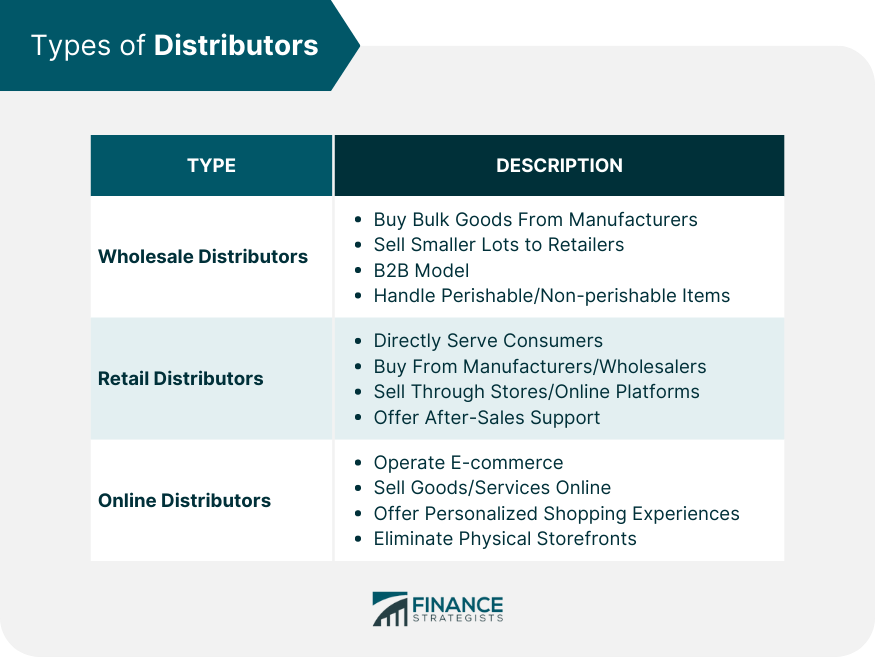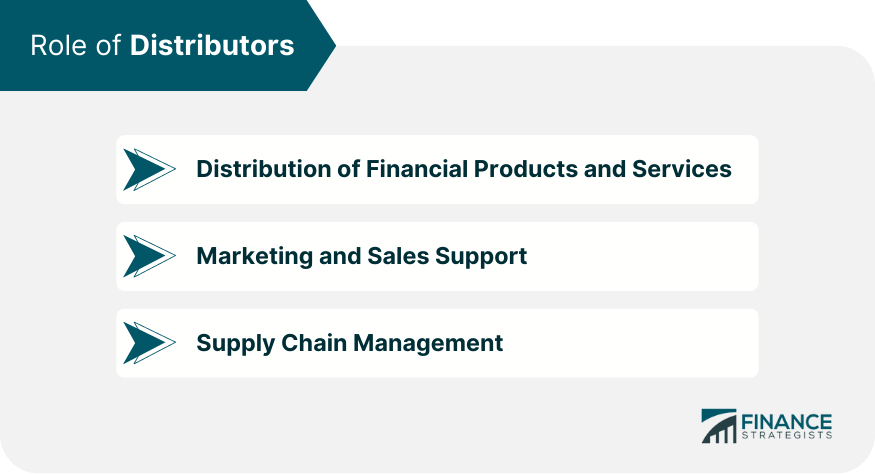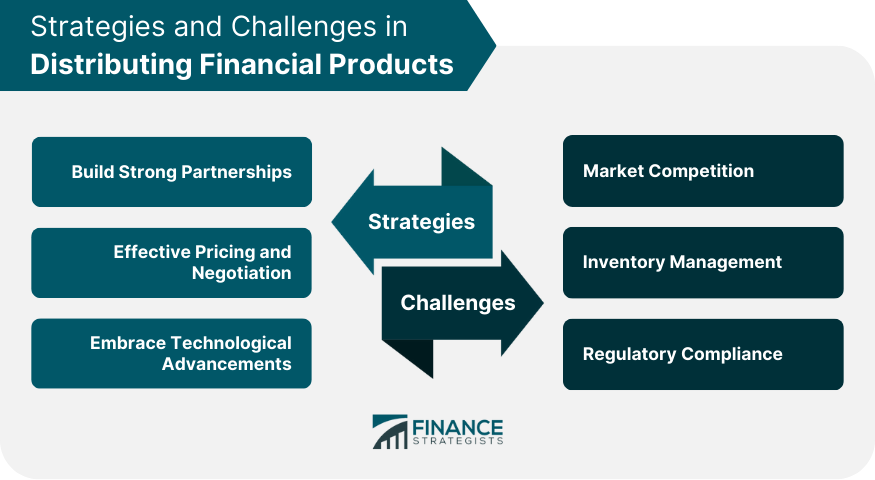A distributor is an entity who purchases bulk amounts of product from a manufacturer and distributes it either directly to consumers or to retailers who then sell to the consumer. Distributors are also sometimes called "Wholesalers". A distributor is a key component of the Supply Chain Model used by both Manufacturers and Retailers because it allows a company to specialize or focus operations on its primary strengths of either producing goods or selling to consumers. They function as intermediaries between manufacturers or suppliers and end users, facilitating the flow of products or services down the supply chain. Distributors acquire products in bulk from suppliers, store them, and subsequently sell them to retailers or directly to the end consumers. Their primary function is to ensure that products or services reach the desired market in the most efficient manner possible. Distributors may also offer value-added services like product training, after-sales support, financing, and marketing assistance, which amplify the value they bring to both suppliers and customers. The business model for distributors is to buy products from a manufacturer at a low price and sell it to retailers or end users at a higher price. In order to maximize profit, the distributor must enter into supply agreements offering low purchase prices for a high markup while focusing on operational efficiencies to keep costs low. Determining goods that may be inexpensively purchased with high markup opportunities requires foresight into market trends and commodity prices. Operating efficiently requires sophisticated infrastructure and route planning. Because of this complexity, many manufacturers and retailers will hire a third-party distributor to distribute products rather than build out their own infrastructure. These entities purchase goods in large quantities from manufacturers or other suppliers and then sell them in smaller lots to retailers. Their operations are largely invisible to end consumers, but their impact on the supply chain is profound. Wholesale distributors often deal with perishable items, such as food and beverages, and non-perishable goods like clothing and electronics. They are typically engaged in the B2B (Business-to-Business) model, serving as an essential link between the manufacturers and the retail outlets. Wholesale distributors can help manufacturers or producers reach a wider network of retailers, reducing the time, effort, and cost associated with product distribution. On the other end of the distribution spectrum are retail distributors. Unlike their wholesale counterparts, retail distributors engage in business transactions with the final consumers. Retail distributors purchase products from manufacturers or wholesalers and sell these directly to the public through brick-and-mortar stores or online platforms. The role of retail distributors goes beyond mere selling; they often provide after-sales services, customer support, and a physical point of contact for product returns or issues. They offer a shopping experience to the consumer, which can significantly influence customer satisfaction and brand perception. Their direct engagement with consumers also means they are key to garnering market insights and customer feedback. With the advancement of technology and the rise of the digital age, online distributors have emerged as a dominant force. They operate on an e-commerce model, selling goods or services over the Internet. This type of distribution eliminates the need for a physical storefront, often resulting in lower operating costs and greater geographic reach. Online distributors range from retailers who solely operate online to those who run parallel online and offline operations. This form of distribution provides customers with convenience and variety, as they can purchase products from anywhere and have them delivered to their doorsteps. In addition, with the surge in data analytics, online distributors can provide personalized shopping experiences, making them an indispensable part of modern commerce. The distribution landscape isn't limited to physical goods. Distributors also play a significant role in the financial sector, where they facilitate the distribution of various financial products and services. These may include insurance policies, mutual funds, credit cards, and loans among others. Financial distributors could be institutions such as banks, non-banking finance companies (NBFCs), or even individuals like brokers and agents. Financial distributors enable financial institutions to extend their reach and penetrate different market segments. They interact directly with customers, understanding their needs and financial goals, and recommending suitable financial products or services. This helps in democratizing access to financial services and contributing to economic growth. Distributors often provide marketing and sales support to manufacturers. This may involve conducting market research, providing customer insights, organizing promotional activities, or even offering product demonstrations. These value-added services not only help in selling the product but also in building brand awareness and reputation. In many cases, distributors maintain close relationships with the retailers and end consumers. They can provide manufacturers with valuable feedback about the product, which can be instrumental in product development and improvement. By acting as a link between the manufacturer and the market, distributors facilitate a two-way flow of information, fostering an environment conducive to growth and adaptation. Distributors are integral components of the supply chain management system. Their tasks extend beyond just buying and selling. They also handle inventory management, order fulfillment, logistics, and transportation. By effectively managing these aspects, distributors can ensure a smooth flow of goods from the manufacturers to the end consumers. Effective supply chain management by distributors can lead to cost savings, improved customer service, and faster time-to-market. These benefits can provide a competitive advantage to both manufacturers and retailers, making distributors an indispensable partner in the business ecosystem. Some companies, such as Wal-Mart, built their empires by having both internal distribution channels as well as retail stores. This creates enhanced communication between the two functions which allows for flexibility and quicker response times to changing markets. For distributors, especially those in the financial sector, building strong partnerships with suppliers is key to success. These suppliers may include banks, insurance companies, and mutual fund houses. By nurturing relationships with suppliers, distributors can ensure a consistent supply of financial products and services, negotiate better terms, and receive support in marketing and sales activities. Building strong partnerships isn't just about business transactions; it's about understanding and aligning with the supplier's strategic objectives. This mutual understanding and cooperation can help in managing risks, solving problems, and achieving shared goals. Successful distribution isn't just about having a wide array of products or services. It's also about pricing these offerings appropriately. Distributors must develop effective pricing strategies that balance profitability with customer satisfaction. This may involve negotiating favorable purchase prices with suppliers, offering competitive prices to customers, or providing value-added services to justify higher prices. Negotiation skills are crucial in this context. Distributors need to negotiate terms and conditions with both suppliers and customers. By mastering negotiation techniques, distributors can secure better deals, improve their profit margins, and strengthen their business relationships. This is particularly relevant for financial distributors, given the increasing digitization of financial services. Distributors can leverage technology to enhance operational efficiency, improve customer service, and gain a competitive edge. For instance, adopting advanced data analytics can help distributors understand customer behavior and preferences, leading to more personalized service. Similarly, leveraging digital platforms can enhance reach, provide convenience to customers, and reduce operational costs. Thus, embracing technology isn't an option, but a necessity for distributors seeking success in today's digital age. One of the primary challenges for distributors is intense market competition. This can come from other distributors, direct selling by manufacturers, or the emergence of new distribution channels. To stay competitive, distributors need to continuously innovate, offer superior customer service, and differentiate themselves from others. Dealing with market competition requires strategic planning, market analysis, and constant adaptation. Distributors need to understand their unique value proposition, identify their target market, and position their offerings appropriately. They also need to keep an eye on market trends and competitor activities to adjust their strategies as needed. Inventory management is a critical challenge for distributors. It involves balancing the need to maintain sufficient inventory to meet customer demand, against the cost of stocking and managing this inventory. Poor inventory management can lead to stock-outs, leading to lost sales, or overstocking, resulting in high storage costs and potential waste from unsold products. Effective inventory management requires careful forecasting, real-time inventory tracking, and efficient logistics and warehousing. Distributors can leverage technology, like inventory management software and AI-powered forecasting tools, to manage their inventory more effectively. Distributors, especially those operating in regulated sectors like finance, face the challenge of regulatory compliance. This involves adhering to a variety of laws, regulations, and industry standards related to their operations. Non-compliance can result in hefty fines, legal consequences, and damage to reputation. To manage compliance effectively, distributors need to understand the regulatory environment they operate in, implement robust compliance systems, and ensure regular staff training. It's important to keep abreast of regulatory changes and updates to ensure ongoing compliance. Distributors bridge the gap between manufacturers or suppliers and end consumers. They facilitate the efficient flow of products or services, enabling companies to focus on their core strengths. They offer value-added services, such as marketing assistance and after-sales support, which benefit both suppliers and customers. There are various types of distributors, including wholesale, retail, and online distributors, each serving different segments of the market. They contribute to economic growth by providing access to financial products and services. Moreover, distributors support manufacturers through marketing, sales support, and supply chain management, resulting in cost savings and improved customer service. To succeed, distributors must build strong partnerships with suppliers, negotiate effectively, embrace technological advancements, and manage challenges like market competition, inventory, and regulatory compliance. In doing so, they can remain competitive, meet customer needs, and thrive in the ever-changing business landscape.Define Distributor in Simple Terms
Distributor Business Model
Types of Distributors
Wholesale Distributors
Retail Distributors
Online Distributors

Role of Distributors
Distribution of Financial Products and Services
Marketing and Sales Support
Supply Chain Management

Distributor Strategy for Successful Distribution
Build Strong Partnerships With Suppliers
Price and Negotiate Effectively
Embrace Technological Advancements
Risks and Challenges for Distributors
Market Competition
Inventory Management
Regulatory Compliance

Conclusion
Distributor FAQs
A distributor is an entity that purchases bulk amounts of product from a manufacturer and distributes it either directly to consumers or to retailers who then sell to the consumer.
Distributors are also sometimes called “Wholesalers,” but the two terms are slightly different than one another.
The business model for distributors is to buy products from a manufacturer at a low price and sell it to retailers or end-users at a higher price.
Some companies, such as Wal-Mart, built their empires by having both internal distribution channels as well as retail stores. This creates enhanced communication between the two functions which allows for flexibility and quicker response times to changing markets.
In commerce, a supply chain is a system of organizations, people, activities, information, and resources involved in supplying a product or service to a consumer.
True Tamplin is a published author, public speaker, CEO of UpDigital, and founder of Finance Strategists.
True is a Certified Educator in Personal Finance (CEPF®), author of The Handy Financial Ratios Guide, a member of the Society for Advancing Business Editing and Writing, contributes to his financial education site, Finance Strategists, and has spoken to various financial communities such as the CFA Institute, as well as university students like his Alma mater, Biola University, where he received a bachelor of science in business and data analytics.
To learn more about True, visit his personal website or view his author profiles on Amazon, Nasdaq and Forbes.















